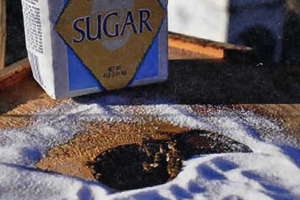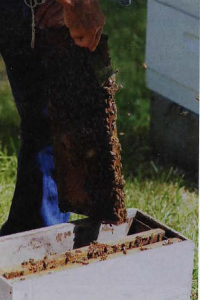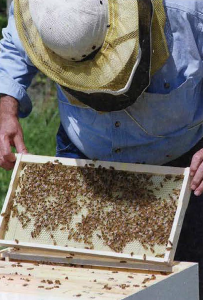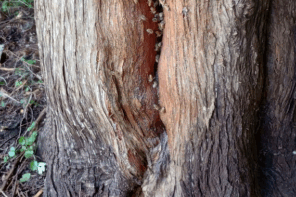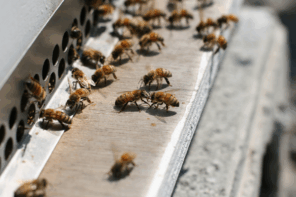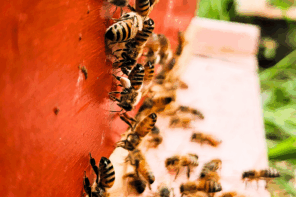By: Phil Craft
This article originally appeared in the Spring 2017 issue of BEEKeeping Your First Three Years
Q: A beekeeper in Virginia writes: I started as a beekeeper two years ago and successfully wintered my one hive the first year. This year I even got two supers of honey! Now I am worried that I left one of them on – that they do not have enough food for this Winter. ls it okay to feed them sugar syrup during the Winter if I catch a warm enough day to open the hive?
A: Phil replies: Congratulations on your success so far. I won’t give you the lecture about Autumn being the time to make sure of food stores. I’m sure you already know that – and it’s not too late to do something. However, there are better choices for cold weather feeding than sugar syrup.
The problem with using syrup in Winter is excess moisture. During most of the year, honey bees store nectar or syrup uncapped until it is reduced to the 18% or less moisture content which is the consistency of honey. ln Winter, the hive is typically less well ventilated (because of entrance reducers and the colony’s diligence in sealing cracks and openings with propolis), and the problem is compounded by the fact that air holds less moisture when it’s cold. Instead of evaporating and being fanned out of the hive, the water is trapped inside. Bees end up, not only cold, but cold and damp. This was really brought home to me several years ago when I overwintered an observation hive in the house. Because it was only two frames between sheets of glass, it didn’t have much room for food storage, so I fed the colony a syrup of two parts sugar to one part water. The bees quickly sucked it down and filled most of the cells, but within an hour the glass was fogged with condensation.
Fondant, also known as bee candy, provides the carbohydrates bees need in a concentrated form without excess water. The candy is not hard to make, and recipes are easy to find on the internet. One calls for combining two cups of granulated sugar, 1 ½ cups of water, two tablespoons of light corn syrup, and 1/8 teaspoon of cream of tartar in a saucepan over medium high heat until it reaches 238° F. A candy thermometer is helpful. Once it reaches the desired temperature, the mixture is removed from the heat, beaten until thick, poured into a mold (such as a cookie sheet lined with wax paper), and allowed to cool and harden. Then it’s just a matter of breaking the slab into pieces and placing them over the inner cover of the brood box. Some beekeepers use variations, such as fondant feeders, but that is the basic method.
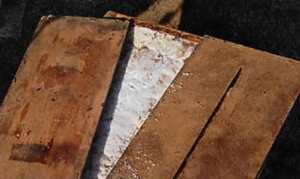
Homemade fondant, or sugar candy can be poured into a temporary mold and left to harden, then placed on a hive for food.
An even simpler alternative is to buy Winter patties from a beekeeping supplier. Very similar to homemade bee candy, they are sugar in a low moisture form. Open the hive just long enough to place a patty on the top bars of the top box, replace the lid, and you are done. A last resort is to sprinkle dry, granulated sugar on the inner cover. This is clearly a desperate measure, but beekeepers have told me that using it has saved colonies from what they thought was certain Winter starvation. Fondant, patties, and sugar can all be placed in the hive any day when the temperature is at least in the 40s.
Be aware that most hive losses from starvation actually occur in late Winter or early Spring as the hive starts to rear brood and runs out of provisions. Keep an eye on your hives and their food stores as Spring approaches.
Q: A beekeeper in Missouri writes: Help! I am a first year beekeeper, and live in Missouri. Last year I purchased my first hive of bees, which was a nuc through my local bee club. I went to bee classes, and tried to stay on top of things. As cold weather approached, and I looked into my hive for the last time, all looked well. Maybe too well my beekeeping friends tell me. I hope to make honey next year, but am afraid that they will swarm in the Spring. I heard a talk on swarm prevention, but it seems complicated. I’m feeling a little stressed out. What suggestion might you have?
A: Phil replies: First of all, relax. You seem to be taking all the right steps, and the problem of a colony so strong that it is ready to reproduce itself is a good one to have. Swarming is nature’s method of making new colonies, and honey bees are hard wired to do it. I think that many beekeepers, and especially new ones, are overly concerned about it. Just as honey bees are programmed to swarm, they are also programmed to leave behind enough bees to rebuild the old colony. In most places in the country, given a good nectar flow, you can still make honey in a hive that has swarmed. That said, no one likes to loose bees, and beekeepers have devised a number of tactics to reduce swarming in their hives -some complicated, and none 100% effective. I say reduce, because we can never stop this very natural process. However, you asked for advice on swarm prevention, so I will tell you how I approach the problem.
Swarming is triggered by overcrowding in the hive, so the most effective and straight forward method of discouraging it is to give the colony more space. In the Spring honey bee colonies react to the increased flow of nectar and pollen into the hive by rearing lots of brood. The result is often crowding and a lack of open comb where the queen can lay eggs. The colony responds by beginning preparations for some of the bees to depart, along with their queen, to a new location. There’s a practical limit to how many brood chambers a hive can consist of (no more than two or three), so the best way to provide more room is to make a nuc.
Nuc is short for nucleus hive, as in the nucleus of a new colony. Making one involves transferring frames of capped brood and a frame or two of food from a strong hive or hives into a new box, then adding a queen. The frames that are removed to make up the nuc are replaced by frames containing foundation. The bees left behind will quickly draw the foundation out, giving the original colony new brood space, so that both crowding and the risk of swarming are reduced. Here is my basic recipe for making a nuc:
• two frames (or more) of capped brood, along with the bees on the frames
• one frame (or more) containing honey and some stored pollen, also with any bees
• one frame (or more) containing new foundation.
• Some extra bees, shaken from an additional brood frames
• A young, mated, caged queen from a beekeeping supplier
Many beekeepers use a nuc box (smaller than a standard hive body and usually designed to hold five frames) for setting up a nuc. Colonies started in them must be transferred to standard boxes after they draw out the foundation and begin to increase in size. Nuc boxes are not a requirement; they are just more convenient for nucs that are intended to be sold or moved later. A nuc is a nuc regardless of the size of the box it is set up in. Starting with a standard size box provides the new colony plenty of room to grow and saves the beekeeper from having to buy a special piece of equipment.
There are two essentials to setting up a nuc. First, avoid accidentally moving the old queen into the nuc. Before transferring any frames, search through the strong hive, find the queen, and place her along with the frame on which you found her in a separate box. Once you have finished making the nuc, move the frame with the queen back into the original hive. If you have difficulty finding her, ask a more experienced beekeeper for help. Second, start the nuc with plenty of bees. After you have set it up with the desired number of frames and inserted the queen cage, take another couple of brood frames and shake bees from them into the nuc until you think you have shaken in too many. The young wax makers and nurse bees needed to grow the new colony will stay (they haven’t yet learned to fly), but the foragers will return to their home hive.

To introduce a queen to your nuc, spread two frames apart, NOT centered, and place your queen cgae between, making sure the bees have access to the queen inside.
If your efforts at prevention are futile, all is not lost. Listen for a louder than usual sound of buzzing and keep an eye on the trees near your hive. After all, a swarm is basically an unhoused nuc.
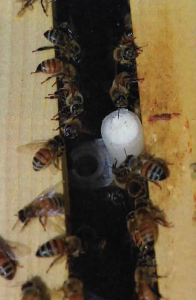
After a week or so, remove the cap or cork that covers the opening, allowing the bees to remove the candy and release the queen.
Q: A beekeeper in Illinois writes: Last month I heard you speak at the Ohio Valley Garden Conference. I am interested in becoming a beekeeper. Do you have some tips on the best way to get started? And I loved your talk!
A: Phil replies: Thanks. People become interested in beekeeping for many reasons. Most think it would be neat to produce their own honey. Some just find insects fascinating. Others, like you, are gardeners and find having bees a natural extension of that hobby. And yes, I have lots of tips, but here are my top 10:
- Buy a good beginning beekeeping book and read it. It will provide you with background information and an overview to beekeeping. There are a lot of good titles out there, but one I recommend is Backyard Beekeeper: An Absolute Beginner’s Guide to Keeping Bees in Your Yard and Garden, by Kim Flottum.
- Search online or contact your state association or state bee inspector to find a local beekeeping group. By attending their meetings you will make contacts with beekeepers who live near you, some as new to the craft as you are, others with many years of experience.
- Attend a beekeeping school, or beginning beekeeping class. Many local and state associations hold evening classes or one day seminars where you can get basic instruction with an opportunity to ask questions. Learn about them through your beekeeping association or your county agriculture extension office.
- Buy a bee veil and beekeeping gloves, and consider a bee suit or coveralls. This will prepare you for step #5.
- Find a mentor through your local bee club, or at least seek out an opportunity to visit with a local beekeeper when he or she is opening and inspecting hives. Some bee clubs host field days, hands-on meetings often held on a Saturday afternoon at a beekeeper’s home or apiary.
- Buy new woodenware. Used boxes and frames may seem like a bargain, but it’s difficult for novice beekeepers to tell the difference between gently used and used up. Moreover, used equipment can harbor honey bee disease pathogens.
- DO NOT buy an established hive from a beekeeper! A full sized, mature colony can be overwhelming for a beginner. It’s better to start with a small colony which will grow with your beekeeping skills.
- Begin with a nuc or a package of bees. A nuc, short for nucleus, is a fully functioning small colony with bees, a queen, brood, and food stores installed in a small hive box. You just transfer it to the standard hive box which you purchased in step #6, and you’re ready to go. A package of bees is a screened box containing several thousand bees and a queen in a separate cage, which require installation in your new equipment. Both nucs and packages have their advantages and drawbacks. You will learn more about them from the book you read in step #1 and classes you take in step #3.
- Start with two hives, if possible. Two are as easy to care for as one, and give you more management options. They also provide a point of comparison when problems arise. It can be difficult for a new beekeeper to recognize abnormalities, but having two hives side by side makes it easier. Even if you don’t know what to do, you’ll know when to ask for advice from you state bee inspector or members of your local group (step #2.)
- Once your hives are set up, put on your bee veil and gloves, and look inside the brood boxes at least every week to 10 days. This is where all the information you’ve acquired will come to life, and you will also be checking to make sure all is well with your bees.
Continue your education by subscribing to a beekeeping magazine, attending meetings of your local bee club, and ASKING QUESTIONS! Good luck, and feel free to send some of those questions to me.
Q: A beekeeper in Kentucky writes: From time to time I see used bee equipment, hives, etc. for sale on craigslist. Isn’t there a risk that they could have mites or diseases?
A: Phil replies: I have two concerns on behalf of beekeepers, especially new beekeepers, considering the purchase of used equipment or existing hives – particularly when they are responding to ads from anonymous sources such as newspapers or the internet. My concerns are lessened if the seller is a member of a local beekeeping group where you attend meetings. However, acquiring equipment is not cheap, and you need to get good value for your money. ln terms of disease, the greatest danger is from brood diseases – those associated with developing bees in brood comb. American Foulbrood is the most common example. This risk may be minimized by avoiding the purchase of frames with drawn comb or even of used frames. When I buy used comb or existing hives, I always conduct a careful examination prior to the purchase. The problem faced by novice beekeepers is that they usually lack the experience to determine whether hive and comb are disease free. I have always cautioned new beekeepers to purchase existing hives only with the advice and assistance of a trusted, more experienced beekeeper (or local inspector if required, and it is in some places). I also suggest that they avoid the purchase of used frames or comb since the cash savings is not worth the risk. For more about disease concerns in used equipment, see the related Q&A, in my February ’13 Ask Phil column.
My other concern for newer beekeepers buying used equipment is the risk of over paying or of paying for something of little value, i.e. worn out equipment. Judging the value of such equipment, especially wooden ware, requires experience that new beekeepers have not yet had time to acquire. So my advice for the novice beekeeper interested in buying used equipment is the same as for those considering the purchase of existing hives. Seek the assistance of an experienced beekeeper in evaluating the used equipment prior to making the purchase. There are some exceptions. Protective clothing: coveralls, gloves and veils, can be evaluated like other used clothing. lf it looks new or has only minor wear, it still has value and a fair market price would be a percentage of the catalog price for similar, new items. If it looks worn out, it probably has little value left in it. Another exception is metalware. Though I would not encourage a novice beekeeper to spend hundreds of dollars on expensive extraction equipment, some inexpensive tools made from metal (such as smokers and hive tools) can also be easily evaluated by observing the amount of wear and comparing the asking price to catalog prices. In summary, if you are unsure of the value of equipment offered for sale, don’t make the purchase. Buy new equipment from a beekeeping supplier.







